|
|
|
|
Uelsen is located in the County of Bentheim (Grafschaft Bentheim) in
the north-
![]() Uelsen in short
Uelsen in short ![]()
![]()
The nice thing with Uelsen is that nothing really exciting seems to happen. Who wants to get excited? Nevertheless, Uelsen is far from being a sleepy village. It stimulates rather than excites. Next to our guests, the local citizens attach great importance to this fact. Uelsen hosts a beautiful outdoor swimming bath, indoor swimming, covered and outdoor tennis courts, two horse riding center as well as sports grounds and gyms. In addition there are extensive cycle tracks, hiking tracks and special horse riding tracks.
The infrastructure is good. There are small shops and craft businesses with a rustic character, but there are also branches of wellknown food stores. In the village you will find banks, doctors, dentists, tax advisers, lawyers and notaries.
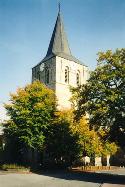
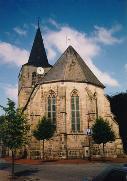 Uelsen has been listed in
old documents since 1131. It used to be an important religious place already
around 700 in the area of the present state Lower-
Uelsen has been listed in
old documents since 1131. It used to be an important religious place already
around 700 in the area of the present state Lower-
![[ Old town hall with peace-oak ]](photos/uelsen-rathaus.jpg)
The old town hall is located next to the Reformed Church. It has lost its original function decades ago. Today it hosts the tourist office and a small historical exhibition. The completion of the town hall in 1649 was made affordable through a donation by Johann Niehoff. Johann Niehoff is a well-known son of Uelsen. He used to be an adventurer and seafarer, sailing the oceans on behalf of the (pre-)dutch trading company VOC (Vereenigde Oostindische Compagnie). His father, originating from Zwolle, was mayor of Uelsen. Johann Niehoff wrote a book about his adventures. He got lost on Madagascar in 1672. See also Wikipedia (English).
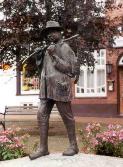
Close to the church and the old town hall, the "Pikmäijer" statue
can be found. The statue has been placed in remembrance of the "Hollandgänger"
in the 17th and 18th century. The Hollandgänger (literally: Holland
walkers), which were called "Pikmäijer" by the locals, were a sort
of cross-
The municipality Uelsen (www.uelsen.de) consists of the seven places Wilsum, Gölenkamp, Halle, Getelo, Itterbeck, Wielen und Uelsen. The locations Höcklenkamp and Lemke have been incorporated to Uelsen.

Occupying 47 square kilometres, Wilsum is the largest community within the municipality Uelsen. Wilsum has a population of 1500. There is a Reformed Church and a Chistian Reformed Church. The parishes have a formative influence on the clerical life at Wilsum. In the hills of Wilsum (Wilsumer Berge) a recreational area has been set up. Many Dutch spend their holidays there. Remnants of the natural wilderness area can be found in the nature reserve "Wilsumer Moor".
Wilsum has got its own internet page at: www.wilsum-online.de.
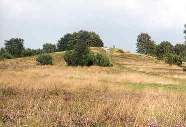
Gölenkamp is the site of the discovery of the "Golden Cup". In 1840
the farmer Pamann found the precious cup, which is said to be the oldest
receptacle ever found in Central Europe. The cup once served as drinking
vessel, the place of discovery "Spöllberg" in Gölenkamp was
a Germanic place of worship at that time. From the Spöllberg (elevation
53.2 m) you have a panoramic view over the county of Bentheim up to the
city of Lingen. Gölenkamp has a size of 20 square kilometres and
hosts 650 inhabitants.
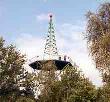
Halle lies south of Uelsen. With a size of 21 square kilometres the community has 700 inhabitants. The former community Hardingen has been integrated into Halle in 1974. The water mill 'Nordbeck' is worth to be visited. In the community part Hesingen is a landscape of prehistoric interest: the so called "burial mound heathland" (Hügelgräberheide). Hesingen is known as the "Lower-county Switzerland" and is a popular trip destination for locals and tourists. In April 1999 an observation tower has been installed there on top of the Lönsberg (elevation 87 m) with a platform 22 m above the ground. From there, you enjoy a great panoramic view. The church steeples of Vasse (NL) and Uelsen can be seen even with foggy weather (although the Uelsen steeple could just be somewhat higher according to some viewers), on a bright day the cities Nordhorn, Lingen and the castle in Bad Bentheim can be seen.
Here you may take a look over the county side: Scenic
View (69 KB).
The Getelo community is 20 square kilometres in size. The community in
the south-west of the municipality Uelsen has 650 inhabitants and extents
along the German-Dutch border. Dutch neighbouring villages are Mander
and Vasse which belong to the community Tubbergen (NL). The holiday park
"Grafschaft Bentheim" is located at Getelo. With the "Söven Pöllen",
Getelo is provided with a prehistorical site of seven burial mounds. Getelo
is also the place of the most modern and capable waterworks in the lower
county. The once rough-
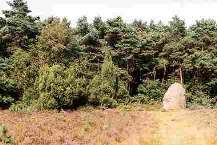
Itterbeck has gone through a change from a small farming village to a
mixed-
Itterbeck has got its own internet page at www.itterbeck-online.de.
What is special to the community Wielen is the fact, that almost the half of the 600 inhabitants are of Dutch nationality. From time immemorial there are close contacts across the border, especially with regard to family affairs. Several pathes and ways cross the "green border". Many schoolchildren visit schools on the other side of the border. Also in a clerical manner many of the inhabitants are oriented towards the Netherlands.
|
|
|
Created: Mar 15, 2001, last modification: Jul 9,
2005 |